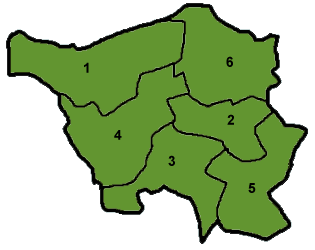| Revision as of 22:50, 28 August 2003 editDen fjättrade ankan~enwiki (talk | contribs)6,322 editsNo edit summary← Previous edit | Revision as of 14:56, 30 September 2003 edit undoSandman~enwiki (talk | contribs)1,190 edits + List of Minister-PresidentsNext edit → | ||
| Line 47: | Line 47: | ||
| After ] the Saarland came under French administration. France and Germany decided in ] to establish an independent Saarland, but these plans were refused in a plebiscite. In new French-German consultations there was an agreement, that Saarland should be allowed to rejoin Germany (Saar Treaty, ], ]). On ], ], Saarland became a part of Germany again. | After ] the Saarland came under French administration. France and Germany decided in ] to establish an independent Saarland, but these plans were refused in a plebiscite. In new French-German consultations there was an agreement, that Saarland should be allowed to rejoin Germany (Saar Treaty, ], ]). On ], ], Saarland became a part of Germany again. | ||
| ==List of Minister-Presidents of the Saarland== | |||
| (or equivalent position) | |||
| # ] - ]: ] | |||
| # ] - ]: ] | |||
| # ] - ]: ] | |||
| # ] - ]: ] | |||
| # ] - ]: ] | |||
| # ] - ]: ] | |||
| # ] - ]: ] | |||
| # ]: ] | |||
| # ] - ]: ] | |||
| # ] - ]: ] (]) | |||
| # ] - ]: ] (SPD) | |||
| # since ]: ] (]) | |||
| ==External links== | ==External links== | ||
Revision as of 14:56, 30 September 2003
| Flag | |
|---|---|
 | |
| Statistics | |
| Capital: | Saarbrücken |
| Area: | 2570 km² |
| Inhabitants: | 1,080,000 (2000) |
| pop. density: | 420 people/km² |
| Homepage: | http://www.saarland.de/ |
| ISO 3166-2: | DE-SL |
| Politics | |
| Minister-President: | Peter Müller (CDU) |
| Ruling party: | CDU |
| Map | |
 | |
With an area of 2570 km² and 1.08 million inhabitants, Saarland is one of the 16 Bundesländer (federal states) in Germany. The capital is Saarbrücken.
Geography
The state borders France in the south, Luxembourg in the west and Rhineland-Palatinate in the north and the east.
It is named after the Saar River, which is an affluent of the Moselle River and runs through the state from the south to the northwest. Most inhabitants live in a city agglomeration on the French border, surrounding the capital of Saarbrücken.
Saarland is divided into six districts:
History
The territory was established in 1920 in accordance with the Treaty of Versailles. It comprised portions of the Prussian Rhine Province and the Rhine Palatinate. The area was put under the control of the League of Nations for 15 years. After this period a plebiscite was held on January 13, 1935: 90.3% of those voting wished to join Nazi Germany . The Nazis called the area "Westmark".
After World War II the Saarland came under French administration. France and Germany decided in 1954 to establish an independent Saarland, but these plans were refused in a plebiscite. In new French-German consultations there was an agreement, that Saarland should be allowed to rejoin Germany (Saar Treaty, October 27, 1956). On January 1, 1957, Saarland became a part of Germany again.
List of Minister-Presidents of the Saarland
(or equivalent position)
- 1945 - 1946: Hans Neureuther
- 1946 - 1947: Erwin Müller
- 1947 - 1955: Johannes Hoffmann
- 1955 - 1956: Heinrich Welsch
- 1956 - 1957: Hubert Ney
- 1957 - 1959: Egon Reinert
- 1959 - 1979: Franz Josef Röder
- 1979: Werner Klumpp
- 1979 - 1985: Werner Zeyer
- 1985 - 1998: Oskar Lafontaine (SPD)
- 1998 - 1999: Reinhard Klimmt (SPD)
- since 1999: Peter Müller (CDU)
External links
- The state's own website, http://www.saarland.de/
- Statistics office, http://www.statistik.saarland.de/
